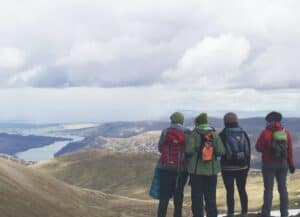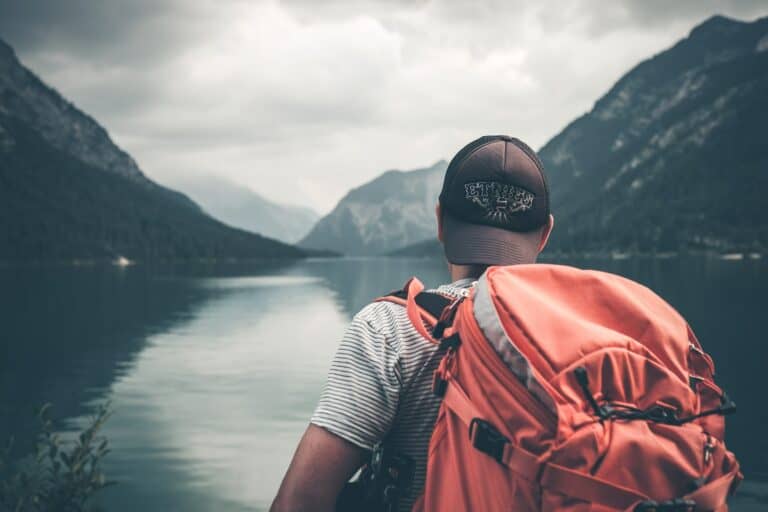So, you’re planning for a big hike? That’s awesome! I’ve been in your shoes before, and I know it can be a bit overwhelming. But don’t worry, I’m here to guide you through this.
How to prepare for a big hike? In this article, we’ll dive into all the essential steps you need to take to prepare for a big hike. We’ll cover everything from choosing the right gear to training your body and even what snacks to pack.
Stay with me, and you’ll be ready to hit the trail with confidence. Let’s get started, shall we?
Choosing the Right Gear

When it’s time to hit the trail, the gear you choose can make or break your hiking experience. Let me guide you in the right direction, so you know what you’ll need for your big hike.
Proper Clothing is a must, your clothing should be both functional and comfortable. Here are a few guidelines to consider:
- Favor breathable materials like moisture-wicking fabrics. They’ll keep you dry and cool even during strenuous exertion.
- Make sure your hiking boots are high-quality and well broken-in to prevent painful blisters.
- Also, don’t forget to pack a rain jacket or poncho, weather in the great outdoors can change in a blink.
Next, you’ll need a good backpack. This isn’t the place to cut corners; a durable, lightweight bag with enough space for your gear is an absolute must.
It’s equally important to consider your hiking equipment. This category includes items like a compass or GPS device for navigation and a first aid kit for emergencies. Remember, the key to selecting your hiking gear is balance, you want to be prepared but not overburdened.
Onto the less obvious but equally essential components of your gear:
- Water purification tablets or a life straw for accessing safe drinking water.
- A multi-tool or Swiss Army Knife, you never know when they might come in handy.
- A headlamp or flashlight with extra batteries, helpful if you get caught out after sundown.
In my experience, I’ve found preparation is vital to a successful, enjoyable hike. It’s not only about what you take on your hike, but how well you’re equipped to handle the unexpected. To recap, choose functional clothing, invest in a high-quality backpack, equip yourself with essential navigation and safety gear, and factor in the unexpected by packing a few just-in-case items.
So grab your gear, strap on your boots – the trails are calling! Our next discussion will be about getting your body ready for the hike.
Creating a Training Schedule
Having tackled the issue of gear selection, let’s now focus on another critical aspect: training for the hike. It’s not enough to just have the right gear; your body also needs to be prepared for the physically demanding challenges that hiking often presents.
Physical preparation is two-fold. First, strengthening your body for the hike, and second, conditioning your mind to deal with the challenging terrains and the psychological challenges that might arise.
You’re probably wondering, where do I start when it comes to training? Well, I’ve broken it down into three key phases: plan, practice, and progress.
Plan
Start by setting realistic and incremental training goals. Your initial goal might be as simple as getting active every day. As you progress, you can increase the duration, intensity, and frequency of your workouts.
Next, map out a training schedule that suits your lifestyle. Remember, consistency is key in training. A steady, regular exercise routine will yield the best results.
Practice
Then comes the practice phase. Put on your hiking boots and take advantage of local parks and trails.
- Try to mimic the conditions of your planned hike as much as you can.
- If your hike will be mountainous, add hill training to your routine.
- Fit in some long walks or hikes into your schedule.
- On top of that, functional strength training for your legs, core, and back can make hiking much more manageable.
Progress
In the progress phase, it’s time to up the ante. Increase the weight of your backpack on practice hikes, and push your endurance levels by increasing your distance and speed.
While we’ve established that physical preparation is vital for hiking, don’t neglect the aspect of mental preparation. The last thing you want is to find yourself in a tough spot and not have the mental fortitude to pull through. Practice controlled breathing, visualization, and positivity to get your mind in shape.
Finally, take note of one crucial thing: give your body time to rest. It is essential for muscle recovery and necessary to avoid injuries.
So there you have it – your guide to creating a training schedule for your big hike. Remember: Plan, Practice, and Progress! Next, we’ll venture into the topic of nourishment and hydration during your hike.
Building Endurance and Strength

Shifting our focus now towards a crucial aspect: building endurance and strength. It’s not just about reaching the top, it’s about making it back down as well. Your body needs to be strong and resilient enough to take on the task. Here’s where a gradual, consistent increase in workout intensity becomes crucial.
Gradual Increase in Intensity
Begin by adding more complex workouts to your routines. But remember it’s not about going from zero to a hundred overnight. You’ve got to take baby steps. Start by increasing the frequency and duration of your workouts each week. But don’t forget to listen to what your body is telling you and to take rest days.
Remember my golden rule – “The right workout shouldn’t leave you gasping for air. It should make you sweat, stimulate your muscles, and accrue some fatigue.” Increment your exercise routine sensibly. It’s about progressing steadily without causing injury.
Targeting the Right Muscles
An effective hiking workout targets your entire body, with special emphasis on certain muscle groups most used during hiking.
Here are those crucial muscles to focus on:
- Quads: They’re your powerhouses when hiking uphill.
- Hamstrings and Glutes: They control your body during those steep, downhill treks.
- Calves: Tricky terrain? These keep you steady.
- Core Muscles: They guarantee balance and good posture throughout your hike.
Incorporate exercises such as squats, lunges, step-ups, and planks in your regime to strengthen these groups. Strengthen your upper body too, as it’s important for stability and maintaining posture.
So, embark on your fitness journey keeping these aspects in focus. Remember, endurance and strength can’t be built overnight. It needs time, persistence, and lots of dedication.
The focus should shift now to discussing nourishment and hydration during a hike. A key takeaway so far – plan better, hike better. Keeping your body properly nourished and hydrated on the trail is an often overlooked detail that can make a big difference in your hiking experience.
Selecting the Right Trail
The next step in preparing for that big hike is choosing the right trail. This important decision shouldn’t be taken lightly. It can actually make or break your hiking experience.
As a first step it’s essential to evaluate your current fitness level. Reflect on the strength and endurance training we’ve discussed. Have you been able to increase your workout intensity gradually? Are the target muscle exercises such as squats, lunges, step-ups, and planks getting easier? The answers to these questions will help determine how strenuous of a trail you can handle.
Take note of the trail’s characteristics. Specifics to identify include the trail length, elevation gain, and trail condition. Be sure to research beforehand with the help of credible sources like government-run park websites or trusted hiking forums. Buddy up with seasoned hikers who can provide beneficial insights.
When you’ve gathered all the information, simply match it with your stamina and skills. For instance, if you’ve been building endurance and strength consistently, you may opt for a longer or more challenging trail. Conversely, if you’re just starting out or if the lunges and planks still leave you panting, look for a shorter or less hilly trail.
Your comfort and safety should always come first in this decision-making process. Remember you’re hiking to enjoy nature at its finest. It’s not a race to finish, but a journey to truly appreciate. Don’t push yourself too hard. Overexerting can lead to injuries, taking the fun away from your wilderness exploration.
Packing Essential Items

After you’ve figured out what trail is just right for you, it’s time to focus on packing the essential items. Here’s where your planning skills truly come into play.
One of the main things I always stress to fellow hikers is the importance of packing light. Bringing unnecessary items can quickly weigh you down and drain your energy. But when we talk about packing light, it does not mean skipping the essentials.
First on the list is water. Hydration is crucial when exerting physical effort – it doesn’t take long for dehydration to set in. I usually suggest packing at least 2 liters of water for a full day’s hike. High energy, easily digestible snacks are also a must. Bars made of fruits and nuts, jerky, or even a simple mix of nuts and dried fruits can be the perfect fuel.
A first aid kit is a non-negotiable part of any hiker’s backpack. Don’t underestimate the wild’s ability to throw unexpected challenges your way. A kit should include, at a minimum:
- Bandages
- Antiseptic wipes
- Tweezers
- Emergency blanket
Clothing-wise, always dress in layers. Even in the height of summer, temperatures can plummet in the evening or in shaded areas. Lightweight, water-resistant outerwear is always a good idea, as well as moisture-wicking inner layers. And never forget a hat and sunscreen, as the sun can be incredibly intense in open, high-altitude areas.
The final essential item, and possibly the most important, is map navigation. Whether it’s an old-school physical map, a GPS device, or a reliable app on your smartphone, being able to find your route is vital.
Remember, preparation is the key to a successful hiking trip. The right tools, the right gear, and the right mindset can turn a regular hike into an extraordinary experience. Without ending on any specific note, I’d say, focus on the preparation and let the adventure fall into place.
Planning for Food and Water

A crucial part of any hiking adventure is ensuring you have enough food and water. Now, remember when I said you need to pack light? Well, that obviously extends to your sustenance as well. Long hiking trips are just like endurance sports. It’s all about high-energy, lightweight food that’s easy to prepare.
Start with water. Hydration is key in any outdoor activity. Experience teaches that you should drink at least 1 liter of water for every 2 hours of hiking. But that’s just a rough guideline. Your mileage, quite literally, may vary depending on things like temperature, trail difficulty, and your personal exertion levels. Also, remember to pack a lightweight, simple-to-use water purifier – an absolute necessity if your journey involves multiple days hiking.
Moving on to food. For the ambitious hiker, planning meals is more than just grabbing a bunch of granola bars. You need balance. Here’s a basic menu:
- Breakfast: Quick oats, dried fruit, powdered milk
- Lunch: Crackers or tortillas, cheese, salami or dehydrated hummus
- Dinner: Pre-packaged freeze-dried meals
- Snacks: Trail mix, energy bars, nut butter
Don’t forget your cooking tools. A lightweight, compact stove that fits in your pack is perfect for this kind of trip. When shopping for one, consider factors like fuel type and availability, stove weight, performance in wind, and boiling times.
The last thing you want is to be underfed or dehydrated on your hiking trip. It’s easy to underestimate how physically demanding hiking can be – especially if it’s done at high altitude where the body needs even more energy to function. Remember, the goal isn’t simply to endure. It’s to fully enjoy this incredible adventure, energized, and above all, in a healthy way.
Preparing for Different Weather Conditions
When it comes to gearing up for hikes, weather is one crucial factor you can’t overlook. Despite the best laid plans, Mother Nature often has a mind of her own, and keeping up with her changing moods is no easy task.
One day it’s sunny, the next it’s snowing – changes in weather are unpredictable and can be extreme. But don’t let this deter you; instead, be prepared for all eventualities.
Dress in Layers
The key to staying comfortable throughout your hike is dressing in layers. This strategy allows you to easily add or remove layers to adjust to changing temperatures and conditions. Your base layer should be moisture-wicking – it’ll keep you dry by drawing sweat away from your skin. Choose a mid-layer for warmth, like a fleece jacket. Your outer layer should be waterproof and wind resistant to protect you from the elements.
Weather-specific Gear
Next thing on the list is your weather-specific gear.
- For hot and sunny conditions, carrying a hat, sunglasses, and sunscreen is a must.
- In cold weather you’ll need gloves, a beanie, and perhaps even thermal socks.
- Rainy weather calls for a high-quality rain jacket, waterproof pants, and possibly gaiters to keep you dry.
Remember, storms can quickly roll in even on clear days, you can’t just consider the forecast for the start of the hike.
Keep an Eye on the Weather
Make it a priority to keep an eye on the weather forecast in the days leading up to your hike. I personally recommend using a reliable weather prediction app for updated weather alerts to stay ahead of any drastic changes.
But don’t rely entirely on forecasts. Along the trail, pay attention to signs of weather changes such as increased wind, dark clouds or sudden drops in temperature.
When fully prepared, varying weather conditions will just add to the thrill of your hike!
But, wait. Are you aware of the importance of first aid and emergency preparedness? Let’s dive into that topic next…
Navigation and Trail Reading Skills
When you’re out there in the wilderness, you might not realize how crucial Navigation and Trail Reading Skills are until you’re face to face with an unmarked fork in the path. Ain’t it true? Well, let’s equip you with some essential tips to help you stand tall in face of such situations.
First off, you don’t need to be an expert cartographer to navigate your hiking trail. However, a basic understanding of topographical maps and a reliable compass can do wonders in helping you stay on track. Topographical maps give detailed information about the terrain – they outline the highs and lows of the landscape, provide information about bodies of water and indicate man-made features like bridges and trails.
Pairing your map with a reliable compass guarantees that you’ll always know the direction you’re heading in. Even if your trail is well marked, it’s always a good idea to double-check your direction – especially at forks or confusing intersections.
Just remember – the magnetic needle of your compass always points toward Earth’s magnetic North pole. Determine the direction of your destination relative to this North direction – that’ll help you follow the correct path.
To help make your hike easier, consider investing in a good quality GPS unit or a smartphone with GPS capabilities. This technology not only provides accurate location information but also tracks your progress which can add an additional safety layer.
But, don’t rely solely on technology! Batteries drain and signal can be lost – true hikers know the importance of good old-fashioned skills and preparation.
Next, let’s consider the “reading the trail” part. Look closely at the trail itself – footprints, worn path, marks or signs on trees, etc. These can offer vital clues on directions and route identification. Sometimes, the trail may not be obvious, thus requiring this basic tracking skill.
Safety Measures and Emergency Preparedness

Now that we’ve discussed the importance of navigation and trail reading, let’s delve into a crucial aspect of hiking preparation: Safety Measures and Emergency Preparedness. Taking the right actions before setting foot on the trail can go a long way in ensuring a safe excursion.
The first thing you’ll want to do is plan your route thoroughly. Study your map carefully to identify any potential hazards along the way. Mark them down and plan your route strategically to avoid these risky areas. Knowing where the risks lie is half the battle in staying safe.
Always remember to share your itinerary with someone not joining you on the hike. Let them know when you plan to start and when they should expect to hear from you again. That way, if something does happen, search and rescue teams have a starting point. A simple text or call could be a lifesaver in an unplanned situation.
Bring along and know how to use essential safety gear. These items can include:
- First Aid Kit
- Whistle
- Multi-Tool Knife
- Fire Starter (matches or lighter)
- Emergency Shelter (like a space blanket or bivvy sack)
Furthermore, ensure you’re familiar with the basic tenets of first aid. Remember, it’s not unusual for rescuers to take several hours, or even days, to reach you in some wilderness areas.
Monitoring weather conditions is another significant safety measure that ought not to be overlooked. Weather on the trail can change rapidly, and what started as a beautiful sunny day could turn to a chilling downpour within hours. So, have a reliable way to check the weather forecast before and during your hike.
Lastly, let’s not forget to respect the wildlife. Keep a safe distance from animals, observe quietly, and never feed them. Consequences of failing to observe these guidelines can be severe, ranging from fines to physical harm.
Remember, every day is a good day when you’re prepared. So, let’s move onto the next stage of hike preparation: proper hiking gear. Stay tuned to find out which pieces of equipment you simply can’t do without on a hike.
Conclusion: How to Prepare for a Big Hike
I’ve walked you through the key steps to prepare for a big hike. We’ve covered the crucial safety measures and the importance of emergency preparedness. Remember, it’s vital to plan your route well and share your itinerary with someone.
Essential safety gear like a first aid kit, whistle, and fire starter should never be overlooked. Monitoring weather conditions and respecting wildlife are other key aspects to consider.
In the next part of your hiking preparation journey, you’ll be focusing on selecting the right gear. This step is just as crucial as the safety measures we’ve discussed. So, lace up those hiking boots, pack your gear, and get ready to hit the trails. Your adventure awaits!

